Mortgage and landlord possession statistics: October to December 2023
Published 8 February 2024
Applies to England and Wales
1. Main Points
This publication provides mortgage and landlord possession statistics up to October to December 2023. In general, we have compared figures to the same quarter in the previous year. Should users wish to compare the latest outturn against previous years, they can do so using the accompanying statistical tables. For technical detail, please refer to the accompanying supporting document.
| Mortgage claims, orders and warrants increased and repossessions decreased. | Compared to the same quarter in 2022, mortgage possession claims increased from 3,163 to 4,384 (39%), orders from 2,482 to 2,702 (9%), warrants from 2,131 to 2,201 (3%) and repossessions by county court bailiffs decreased from 735 to 593 (19%). |
| Landlord possession actions have all increased. | When compared to the same quarter in 2022, landlord possession claims increased from 20,457 to 23,382 (14%), orders from 16,145 to 18,003 (12%), warrants from 8,778 to 9,833 (12%) and repossessions from 5,427 to 6,649 (23%). |
| Mortgage and Landlord possession claims rates have risen across all regions. | Increases in possession claims have been recorded in all regions. Private and social landlord claims remained concentrated in London (with 7 and 1 of the highest 10 claim rates respectively). |
| Mortgage median average time (from claim to repossession) has decreased. | The median average time from claim to mortgage repossession has decreased to 50.5 weeks, down from 63.7 weeks in the same period in 2022. |
| Median timeliness for landlord repossessions has increased. | The median average time from claim to landlord repossession has increased to 23.7 weeks, up from 21.7 weeks in the same period in 2022. |
A data visualisation tool has also been published that provides further breakdowns in a web-based application. The tool can be found here.
For feedback related to the content of this publication and visualisation tool, please contact us at CAJS@justice.gov.uk
2. Statistician’s Comment
Mortgage and Landlord possession actions have continued their steady growth in 2023. Mortgage possession claims now sit around 65% of what it was in 2019. The statistics this quarter shows mortgage possession actions have continued their gradual upward trend with mortgage claims at their highest since 2019. This quarter, claims, orders and warrants are 39%, 9% and 3% respectively above the previous year’s level, while repossessions were 19% below the previous year’s levels.
Landlord claims have increased at a faster pace and now make up around 85% of the 2019 baseline. Landlord possession actions have followed a similar upward trend mainly driven by Accelerated and Private landlord possession claims which have continued to rise and are currently back to their pre-covid baseline. In the Accelerated procedure, the rise is across all the action types of claims (16%), orders (20%), warrants (25%) and repossessions (34%) when compared to the same quarter last year.
Effects of measures put in place during the year to tackle timeliness is evidenced in the reduction of median timeliness across most actions. Mortgage claim to orders, claim to warrant and claim to repossession have decreased for the second consecutive quarter. While median timeliness figures have decreased for landlord orders and warrants returning to pre-Covid levels.
3. Overview of Mortgage Possession
Mortgage possession actions: claims, orders and warrants are currently above the previous year’s levels, while repossessions have decreased.
Compared to the same quarter in 2022, mortgage possession claims (4,384) are up 39%. Mortgage orders for possession (2,702) are up 9%, warrants issued (2,201) are up 3% and repossessions (593) are down 19%.
Figure 1: Mortgage possession actions in the county courts of England and Wales, October to December 2018 to October to December 2023 (Source: Table 1)
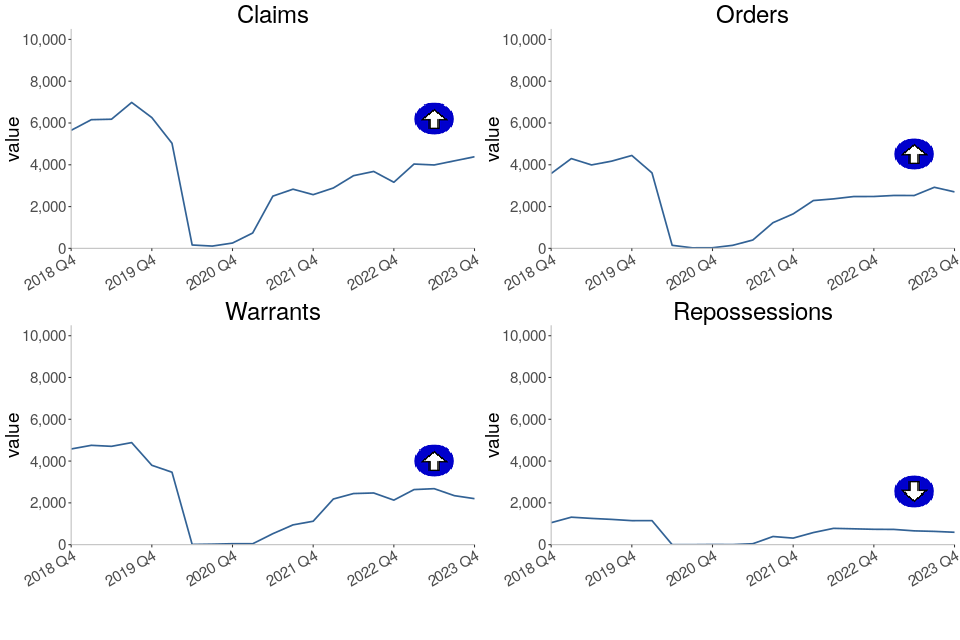
All mortgage possession case types have been steadily increasing since Q2 2021 (apart from a small dip in Q4 2021 and Q4 2022). However, these are showing early signs of stabilising in the current quarter, although it is not yet known if this trend will continue. Claims, warrants and repossessions volumes are now 30%, 42% and 48% below their pre-covid baseline. This is a significant increase when compared to the same quarters in 2020 to 2022. However it is still short of the pre-covid 2019 baseline.
Mortgage possession claims fell from a peak of 26,419 in April to June 2009 (in the aftermath of the 2008 financial crash) before stabilising from April to June 2015 (4,849, see table 1). In the most recent quarter, October to December 2023, there were 4,384 claims for possession, up 39% from the same quarter in 2022.
Orders and warrants for possession followed a similar trend to mortgage claims, falling from a peak of 23,850 orders in July to September 2009 and 21,350 warrants in January to March 2009, and stabilizing around 2016/17. Compared to the same quarter in 2022, orders are up 9% to 2,702 and warrants are up 3% to 2,201 in October to December 2023.
Historically, repossessions by county court bailiffs fell from a high of 9,284 in Q1 of 2009 to 934 in Q3 of 2018, the lowest recorded level of the series at the time. Following the complete cessation of repossession proceedings from March to September 2020 where no repossessions took place, the FCA guidance advised mortgage lenders not to commence or continue possession proceedings until April 2021 (unless there were special circumstances). As a result, there were only 10 repossessions from April 2020 to March 2021 (Q2 2020 to Q1 2021), this increased consistently after the Covid measures came to an end, to a peak of 780 in Q2 2022. Since then, it has been declining and is at 593 this quarter, down 19% from the previous year.
Before the impact of coronavirus, the historical fall in the number of mortgage possession actions since 2008 has generally coincided with lower interest rates, a proactive approach from lenders in managing consumers in financial difficulties and other interventions, such as the Mortgage Rescue Scheme and the introduction of the Mortgage Pre-Action Protocol. The trend seen in recent years mirrors that seen in the proportion of owner-occupiers.
4. Mortgage Possession Action Timeliness
Median timeliness figures have decreased for all actions; claim to orders, claim to warrant and claim to repossession for the second consecutive quarter.
The median average time from claim to repossession has decreased to 50.5 weeks, down from 63.7 weeks in the same period in 2022.
Figure 2: Average timeliness of mortgage possession actions, October to December 2018 to October to December 2023 (Source: Table 3)
Number of weeks taken from initial mortgage claim to…
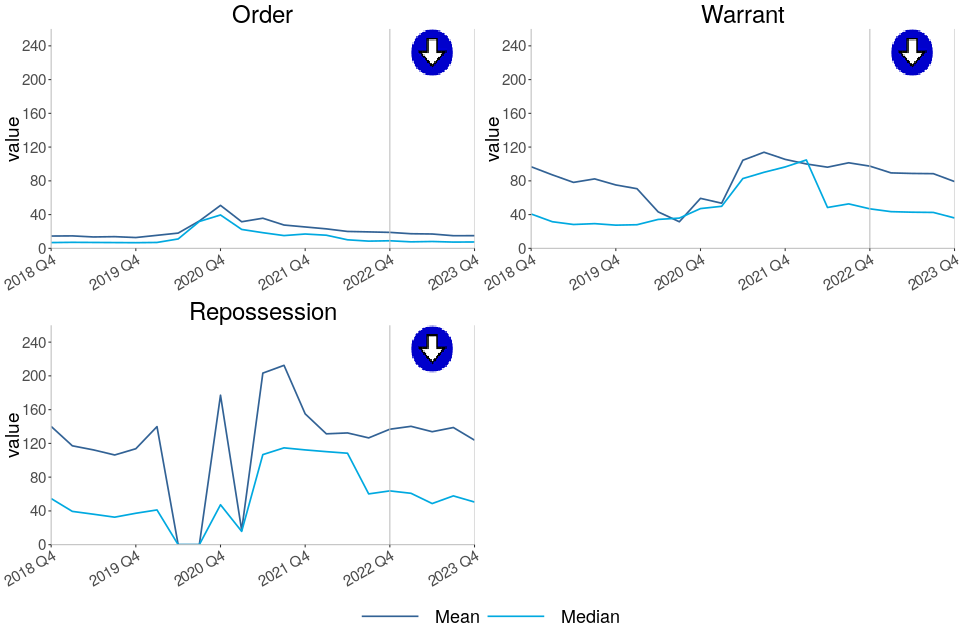
Time taken to complete mortgage actions have all decreased again this quarter following a push from courts to reduce backlogs and ensure swift access to justice. This quarter;
-
Claims to order median timeliness has decreased to 7.6 weeks, down from 9.0 weeks in the same period in 2022.
-
Claims to warrant median timeliness has decreased to 36.0 weeks, down from 46.9 weeks in the same period in 2022.
-
Claims to repossession median timeliness has decreased to 50.5 weeks, down from 63.7 weeks in the same period in 2022.
The trend for mortgage possession timeliness is driven by outright orders, which make up over two thirds (70%) of all cases. In the most recent quarter, the median time taken from claim to repossession was 42.1 weeks for outright orders, and 250.1 weeks for suspended orders.
The above charts distinguish between the timeliness of possession claims at different stages of a case. Average time taken from claim to warrant or repossession can fluctuate and is affected by various factors. For example, the final two charts take account of the amount of time between the court order being issued and the claimant, such as the mortgage lender, applying for a warrant of possession.
The long-term increases in the mean average time from claim to warrant and claim to repossession are due to an increasing proportion of historic claims reaching the warrant and repossession stages respectively in recent quarters. This is possibly due to defendants recently breaking the terms of the mortgage agreements put in place at the start of the process. Although these historical outlying cases inflate the mean average, they have less effect on the median.
5. Overview of Landlord Possession
The number of landlord possession actions for all court stages have increased compared to the same quarter of last year.
Compared to the same quarter in 2022, landlord possession actions; claims (23,382), orders for possession (18,003), warrants (9,833) and repossessions (6,649) have increased by 14%, 12%, 12% and 23% respectively.
Figure 3: Landlord possession actions in the county courts of England and Wales, October to December 2018 to October to December 2023 (Source: Table 4)
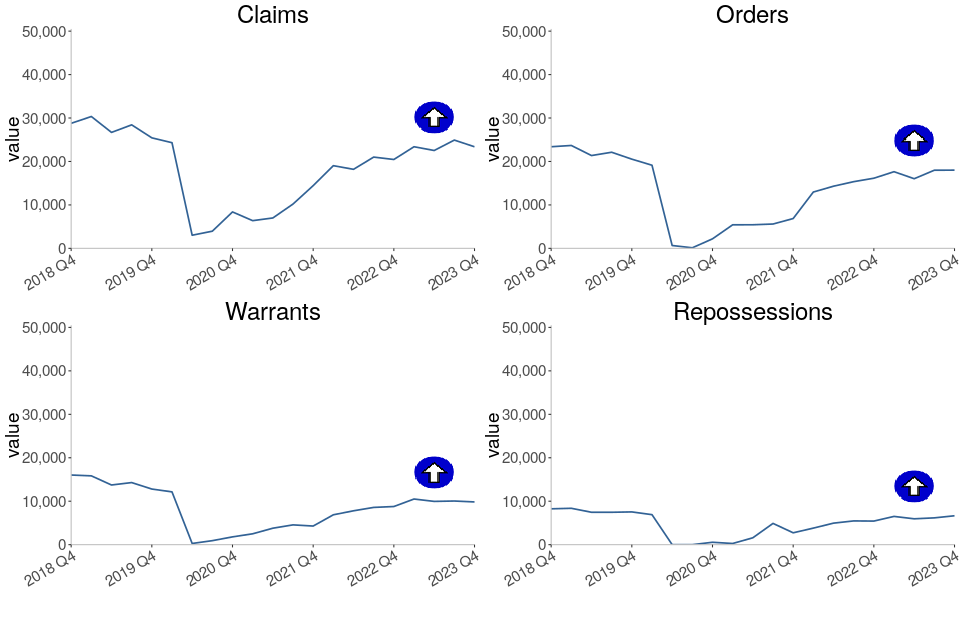
Landlord possession actions have been increasing since Q2 2021 and they are now at their highest levels since the pandemic. Claims, orders and warrants volumes increased by 14%, 12% and 12% respectively while landlord repossessions in the county courts rose by 23% when compared to the same quarter in 2022.
Within the landlord possession actions, the Accelerated procedures have particularly risen across all claims (16%), orders (20%), warrants (25%) and repossessions (34%). This increase is driven by accelerated procedures in England. Volumes in Wales are starting to decline.
Accelerated procedures numbers for England have increased across all actions – claims (23%), orders (29%), warrants (31%) and repossessions (39%).
In Wales, accelerated procedures numbers have decreased after reaching a peak in Jan to March 2023. Accelerated procedures numbers for Wales have decreased across all actions – claims (78%), orders (69%), warrants (52%) and repossessions (33%). The differences in trends seen in England and Wales is likely due to the difference in the introduction of the Renters Reform Bill in these countries and the time taken for the effects to work through the system.
In October to December 2023, 36% or 8,522 of all landlord possession claims were social landlord claims compared to private landlord claims (31% or 7,225). 33% (7,635) were accelerated claims. This contrasts with pre-covid proportions when a majority of claims (around 60%) were social landlord claims.
The rise in claim and orders volumes is observed across most geographical regions. As in previous quarters, a concentration was seen in London, with 7,638 landlord claims and 5,493 landlord orders at London courts in October to December 2023, accounting for 33% and 31% of the respective totals. In London, there was an increase of 32% (from 5,805 in October to December 2022) for landlord claims and an increase of 25% for landlord orders (from 4,386 in October to December 2022).
The 12% increase in landlord warrants compared to October to December 2022, was accompanied by increases across all regions. The largest regional number (3,262) was again found in London, making up 33% of all landlord warrants. There was an increase of 18% for landlord warrants in London (from 2,774 in October to December 2022 to 3,262 in October to December 2023).
A new Housing Loss Prevention Advice Service (HLPAS) was launched on 1 August to provide advice to tenants and homeowners as soon as they are served with a written notice asking them to leave their home. Individuals who require the service do not need to meet legal aid financial eligibility rules as the service is not means tested but they are required to show evidence that they are at risk of losing of their home. More information can be found here.
6. Landlord Possession Timeliness
Median timeliness figures have decreased for landlord orders and warrants returning to pre-Covid levels.
The median average time from claim to repossession has increased to 23.7 weeks, up from 21.7 weeks in the same period of 2022.
Timeliness figures are higher than the legal guidelines. The law requires at least 4 and no more than 8 weeks between claim and court hearing. Possession orders stipulate when a tenant must vacate the property - typically within 4 weeks from the date the order was made. Landlords cannot issue a warrant until after this period (if the tenant has failed to comply).
Figure 4: Mean and median average timeliness of landlord possession actions, October to December 2018 to October to December 2023 (Source: Table 6)
Number of weeks taken from initial landlord claim to…

The median time taken to complete landlord actions decreased for orders and warrants this quarter following a general downward trend since Q3 2021 and is now around what it was before the pandemic.
-
Claims to order median timeliness has decreased to 7.6 weeks, down from 8.1 weeks in the same period in 2022.
-
Claims to warrant median timeliness has decreased to 14.6 weeks, down from 15.7 weeks in the same period in 2022.
-
Claims to repossessions median timeliness has increased to 23.7 weeks, up from 21.7 weeks in the same period in 2022.
As shown by Figure 4, median figures are generally considerably lower than mean figures, demonstrating that on average, the progression from claim to successive stages can be positively skewed by outlying cases.
7. Regional Possession Claims
Since Q4 2022, the methodology used for calculating the rates of possession claims and repossessions had been modified to take into account the variation in proportions of tenure types in each local authority (LA) as measured by the 2021 census. The previous methodology (in place prior to Q4 2022) used total household figures as the denominator for all claims and repossessions rates. Since Q4 2022, this has now been modified to use household volumes by tenure[footnote 1]; mortgage, social and private landlord volumes for each local authority. For example, the rate of mortgage claims is now calculated as the number of mortgage claims divided by the number of households owned by a mortgage or loan in each LA. Similarly, rates for private and social landlord claims and repossessions have now been calculated separately[footnote 2] as a rate of households in each LA owned by a private or social landlord respectively. More information on this change is provided in the accompanying guide.
Westminster, in the London region, had the highest rate of mortgage possession claims at 214 per 100,000 households owned by mortgage or loan, followed by Kensington and Chelsea (London region) and Brent (London region); with 177 and 166 claims per 100,000 respectively.
The highest private landlord possession claim rates were found in London, with 7 of the 10 highest rates occurring in this region. Barking and Dagenham had the highest rate for private landlord claims (676 per 100,000 households owned by a private landlord).
The highest social landlord possession claim rates were found in West Midlands and South East with 3 each of the 10 highest rates occurring in this region. Cotswold in the South West had the highest rate for social landlord claims (706 per 100,000 households owned by a social landlord).
Figure 5: Mortgage possession Claims per 100,000 households owned by a mortgage or loan, October to December 2023 (Source: map.csv; see supporting guide)
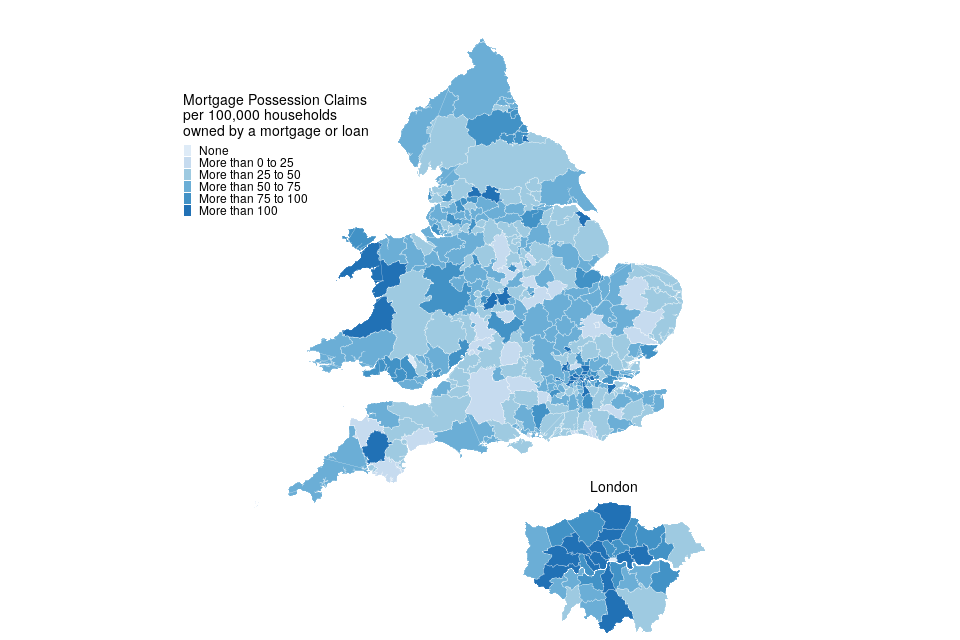
| Local Authority | Rate (per 100,000 households owned by a mortgage or loan) | Actual number |
|---|---|---|
| Westminster | 214 | 23 |
| Kensington and Chelsea | 177 | 14 |
| Brent | 166 | 36 |
3 local authorities had no mortgage possession claims during this period. Excluding these, Hart had the lowest rate of mortgage claims (6.5 per 100,000 households owned by a mortgage or loan).
Figure 6: Private landlord possession Claims per 100,000 households owned by a private landlord, October to December 2023 (Source: map.csv; see supporting guide)

| Local Authority | Rate (per 100,000 households owned by a private landlord) | Actual number |
|---|---|---|
| Barking and Dagenham | 676 | 121 |
| Redbridge | 529 | 167 |
| Enfield | 497 | 176 |
London boroughs accounted for 7 of the 10 local authorities with the highest rate of private landlord claims.
3 local authorities had no private landlord claims during this period. Excluding this, Erewash in East Midlands had the lowest rate of private landlord claims (11.8 per 100,000 households owned by a private landlord).
Figure 7: Social landlord possession Claims per 100,000 households owned by a social landlord, October to December 2023 (Source: map.csv; see supporting guide)

| Local Authority | Rate (per 100,000 households owned by a social landlord) | Actual number |
|---|---|---|
| Cotswold | 706 | 44 |
| Solihull | 583 | 73 |
| Lambeth | 557 | 252 |
West Midlands and South East had 3 each of the highest rates of social landlord possession claims..
7 local authorities had no social landlord claims during this period. Excluding this, East Hampshire had the lowest rate of social landlord claims (15.1 per 100,000 households owned by a social landlord).
8. Regional Repossessions (by County Court Bailiffs)
Westminster in London had the highest overall rate of mortgage repossessions at 56 per 100,000 households owned by a mortgage or loan.
Private landlord repossessions were highest in Tendring, East of England with 150 per 100,000 households owned by a private landlord.
Social landlord repossessions were highest in Torbay, South West with 153 per 100,000 households owned by a social landlord.
Figure 8: Mortgage repossessions per 100,000 households owned by a mortgage or loan, October to December 2023 (Source: map.csv; see supporting guide)
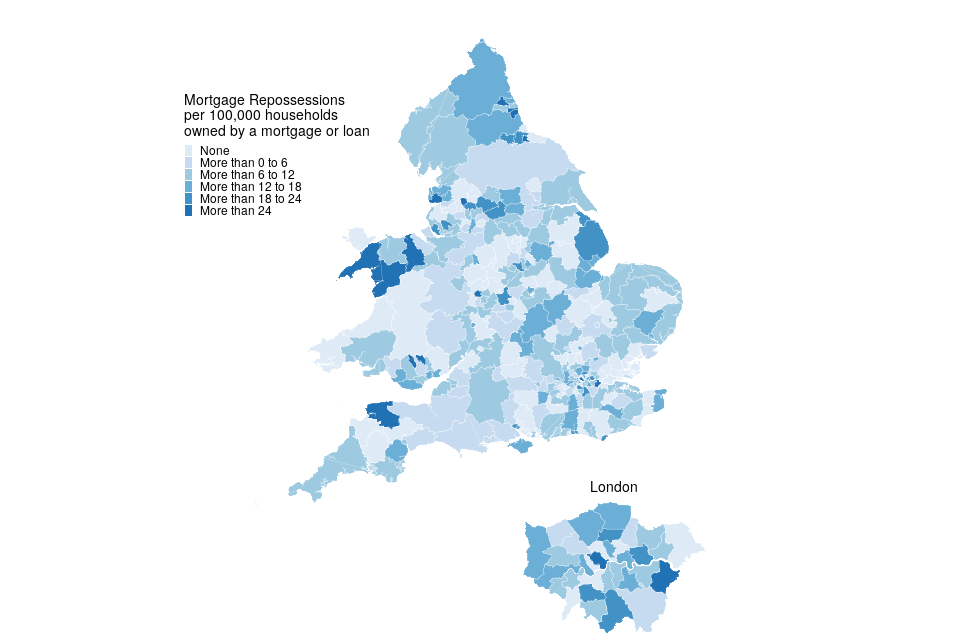
| Local Authority | Rate (per 100,000 households owned by a mortgage or loan) | Actual number |
|---|---|---|
| Westminster | 56 | <10 |
| Hyndburn | 40 | <10 |
| Fylde | 38 | <10 |
No repossessions by county court bailiffs were recorded during this period in 97 local authorities out of a total of 318.
Figure 9: Private landlord repossessions per 100,000 households owned by a private landlord, October to December 2023 (Source: map.csv; see supporting guide)
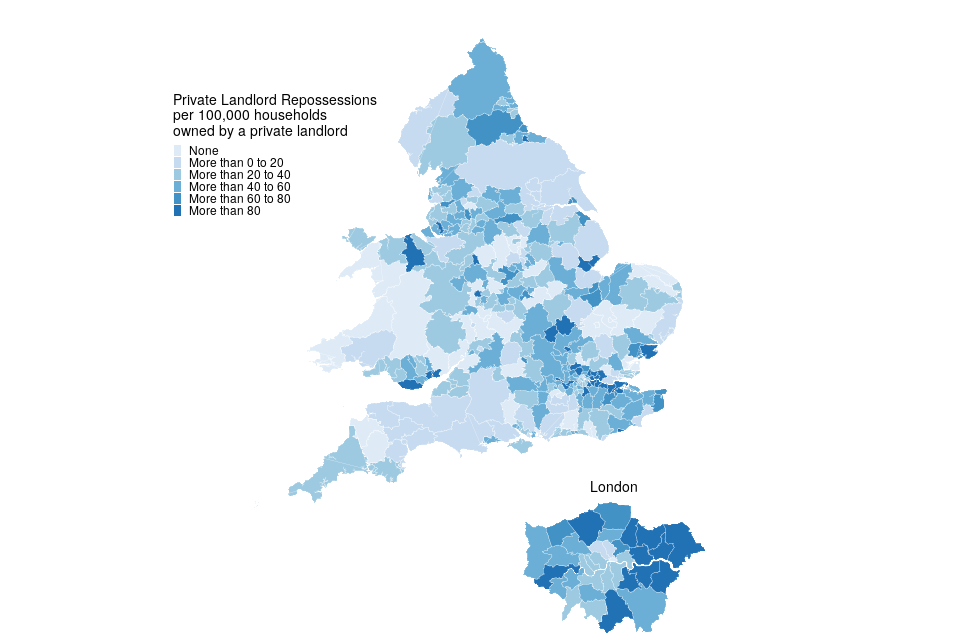
| Local Authority | Rate (per 100,000 households owned by a private landlord) | Actual number |
|---|---|---|
| Tendring | 150 | 20 |
| Dartford | 145 | 12 |
| Lewisham | 144 | 48 |
London local authorities account for 5 of the 10 boroughs with the highest rate of private landlord repossessions.
45 local authorities had no private landlord repossessions by county court bailiffs in October to December 2023.
Figure 10: Social landlord repossessions per 100,000 households owned by a social landlord, October to December 2023 (Source: map.csv; see supporting guide)
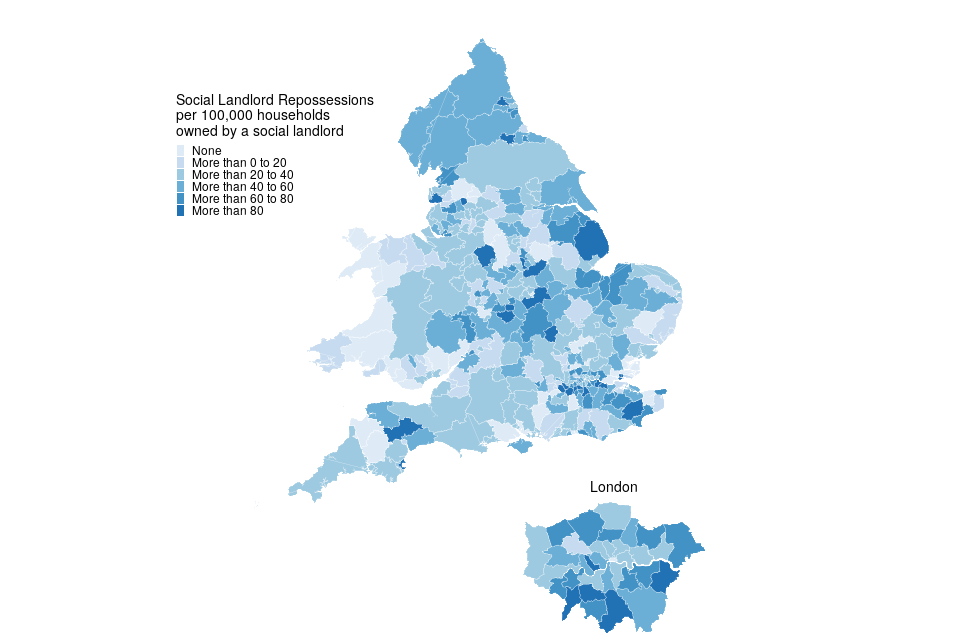
| Local Authority | Rate (per 100,000 households owned by a social landlord) | Actual number |
|---|---|---|
| Torbay | 153 | <10 |
| Dartford | 143 | <10 |
| Harborough | 142 | <10 |
London local authorities account for 3 of the 10 boroughs with the highest rate of social landlord repossessions.
40 local authorities had no social landlord repossessions by county court bailiffs in October to December 2023.
As with claims, it should be noted that for some of these areas the rates are based on a small number of possessions.
9. Further information
The statistics in the latest quarter are provisional and revisions may be made when the next edition of this bulletin is published. If revisions are needed in subsequent quarters, these will be annotated in the tables.
9.1 Accompanying files
As well as this bulletin, the following products are published as part of this release:
-
A supporting guide providing further information on how the data is collected and processed, including a guide to the csv files, as well as legislation relevant to mortgage possessions and background information.
-
A set of overview tables, covering key sections of this bulletin.
-
CSV files of the map data and the possession action volumes by local authority and county court.
-
A data visualisation tool which provides a detailed view of the Mortgage and Landlord statistics. We welcome feedback on this tool to help improve it in later editions and to ensure it meets user needs.
9.2 National Statistics status
National Statistics are accredited official statistics (https://osr.statisticsauthority.gov.uk/accredited-official-statistics/) that meet the highest standards of trustworthiness, quality and public value.
Accredited official statistics are called National Statistics in the Statistics and Registration Service Act 2007. These accredited official statistics were independently reviewed by the Office for Statistics Regulation in September 2021. They comply with the standards of trustworthiness, quality and value in the Code of Practice for Statistics and should be labelled ‘accredited official statistics’.
It is the Ministry of Justice’s responsibility to maintain compliance with the standards expected for National Statistics. If we become concerned about whether these statistics are still meeting the appropriate standards, we will discuss any concerns with the Authority promptly. National Statistics status can be removed at any point when the highest standards are not maintained, and reinstated when the standards are restored. These statistics have been audited and re-accredited as National Statistics. The most recent compliance check completed by the Office of Statistics Regulation can be found here.
9.3 Future publications
Our statisticians regularly review the content of publications. Development of new and improved statistical outputs is usually dependent on reallocating existing resources. As part of our continual review and prioritisation, we welcome user feedback on existing outputs including content, breadth, frequency and methodology. Please send any comments you have on this publication including suggestions for further developments or reductions in content.
9.4 Contact
Press enquiries should be directed to the Department for Levelling Up, Housing and Communities press office:
email: newsdesk@levellingup.gov.uk
Other enquiries and feedback on these statistics should be directed to the Data and Evidence as a Service division of the Ministry of Justice:
Carly Gray - email: CAJS@justice.gov.uk
Next update: 16 May 2024
© Crown Copyright
Produced by the Ministry of Justice
Alternative formats are available upon request from ESD@justice.gov.uk
-
Tenure - Office for National Statistics ons.gov.uk. ↩
-
Please note rates for private and social landlord possession claims and repossessions do not include accelerated claims. This is because accelerated claims are recorded onto the case management system at point of entry so do not specify the tenure type. ↩
